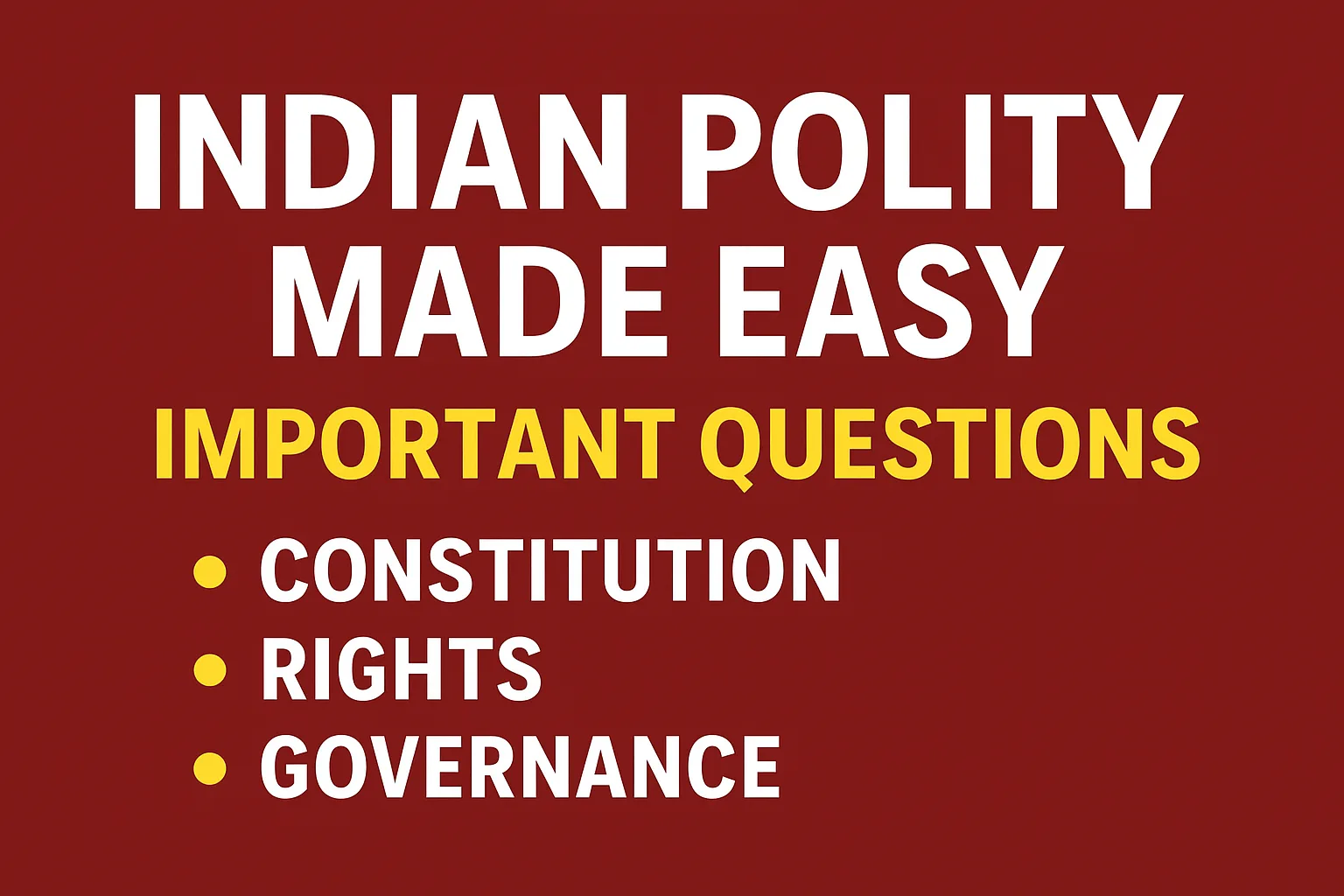Studying political science, especially the Indian Constitution and government system, is important to understand how our country is run. It helps us learn about our rights, duties, and how different parts of the government work. This includes learning about the Parliament, President, courts, elections, and how laws are made and followed. Knowing these things helps people take part in democracy in a better way and is also useful for those preparing for competitive exams. The 25 multiple-choice questions below cover important topics like the Constitution, rights, duties, government bodies, and elections. Solving them will help you improve your knowledge, thinking skills, and exam preparation in Indian polity.
Who is recognized as the constitutional head of the Union Government in India, holding the highest constitutional authority?
A) Prime Minister
B) President
C) Vice President
D) Chief Justice
Answer: B) President
In which part of the Indian Constitution are the Fundamental Rights of Indian citizens clearly laid out and protected?
A) Part I
B) Part III
C) Part IV
D) Part V
Answer: B) Part III
Directive Principles help the government make good rules for the people’s welfare are written in Which part of the Constitution?
A) Part III
B) Part IV
C) Part V
D) Part VI
Answer: B) Part IV
Who has the authority to appoint the Chief Justice of India, the highest-ranking judge in the Supreme Court?
A) President
B) Prime Minister
C) Parliament
D) Union Minister of Law
Answer: A) President
As per the Indian Constitution, what is the highest number of members allowed in the Lok Sabha?
A) 500
B) 525
C) 550
D) 552
Answer: D) 552
Who is responsible for electing the Vice President of India according to the Indian electoral system?
A) Members of Parliament only
B) Members of Lok Sabha only
C) Members of Rajya Sabha only
D) Members of Parliament and State Legislatures
Answer: A) Members of Parliament only
How many years does a Rajya Sabha member stay in office for one full term?
A) 4 years
B) 5 years
C) 6 years
D) 7 years
Answer: C) 6 years
Which constitutional amendment granted the Right to Education as a part of the Fundamental Rights in India?
A) 73rd Amendment
B) 86th Amendment
C) 42nd Amendment
D) 44th Amendment
Answer: B) 86th Amendment
When both Lok Sabha and Rajya Sabha don’t agree on a bill, who chairs their joint meeting?
A) President
B) Prime Minister
C) Lok Sabha Speaker
D) Rajya Sabha Chairman
Answer: C) Lok Sabha Speaker
The doctrine of the Separation of Powers, where different branches of government have distinct roles, was adopted in the Indian Constitution from which country’s system?
A) United Kingdom
B) United States of America
C) France
D) Australia
Answer: B) United States of America
Which Schedule of the Indian Constitution outlines the distribution of powers and responsibilities between the Union and the States?
A) Fourth Schedule
B) Fifth Schedule
C) Seventh Schedule
D) Ninth Schedule
Answer: C) Seventh Schedule
The Fundamental Duties of Indian citizens were introduced through which amendment to the Constitution?
A) 42nd Amendment
B) 44th Amendment
C) 73rd Amendment
D) 86th Amendment
Answer: A) 42nd Amendment
Which one of the following choose the salary and allowances of the President of India?
A) Prime Minister
B) Parliament
C) Supreme Court
D) Finance Commission
Answer: B) Parliament
Which term is used to describe the Indian political system that blends elements of federalism and unitary governance?
A) Parliamentary
B) Quasi-Federal
C) Republic
D) Confederation
Answer: B) Quasi-Federal
The President of India can dissolve the Lok Sabha only on the advice of which constitutional authority?
A) Union Cabinet
B) Prime Minister
C) Speaker of Lok Sabha
D) Chairman of Rajya Sabha
Answer: B) Prime Minister
Under Article 72 of the Indian Constitution, who is empowered to grant pardons and other forms of clemency to convicts?
A) Supreme Court
B) President of India
C) Parliament
D) Prime Minister
Answer: B) President of India
What is the maximum number of members that the Rajya Sabha, the Upper House of Parliament, can have according to the Constitution?
A) 245
B) 250
C) 260
D) 270
Answer: A) 245
The concept of Judicial Review, which allows courts to examine the constitutionality of laws, has been borrowed by India from which country?
A) United Kingdom
B) United States of America
C) Canada
D) Australia
Answer: B) United States of America
In 1929, which important resolution aimed at complete independence (Purna Swaraj) was adopted by the Indian National Congress?
A) Lahore Resolution
B) Nehru Report
C) Purna Swaraj
D) Lucknow Pact
Answer: C) Purna Swaraj
A) President
B) Members of Parliament (MPs)
C) Prime Minister
D) Governors
Answer: B) Members of Parliament (MPs)
Which group of Articles in the Indian Constitution deals specifically with Emergency Provisions for various national crises?
A) Articles 352 to 360
B) Articles 356 to 360
C) Articles 352 to 358
D) Articles 360 to 365
Answer: A) Articles 352 to 360
First woman chosen as the President of India?
A) Pratibha Patil
B) Sarojini Naidu
C) Indira Gandhi
D) Vijayalakshmi Pandit
Answer: A) Pratibha Patil
What is the age at which judges of the Supreme Court of India must retire?
A) 60 years
B) 62 years
C) 65 years
D) 67 years
Answer: C) 65 years
As per the beginning part of the Indian Constitution, how is India described?
A) Socialist Republic
B) Democratic Republic
C) Sovereign Socialist Secular Democratic Republic
D) Federal Republic
Answer: C) Sovereign Socialist Secular Democratic Republic
Who is known as the first citizen of India according to the Constitution?
A) Prime Minister
B) President
C) Vice President
D) Chief Justice of India
Answer: B) President

It’s helpful